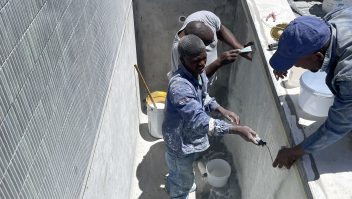

Is your pool looking tired or cracked? Swimming pool resurfacing in South Africa is one of the most effective ways to restore beauty, safety, and value. Whether you’re dealing with worn-out marbelite, fading fibreglass, or dated tiles, resurfacing gives your pool a second life—without the cost of a full rebuild. Explore our full range of services.
How much does it cost to resurface a pool in South Africa?
The cost to resurface a swimming pool in South Africa typically ranges from R15,000 to R60,000, depending on:
- Pool size
- Material used (e.g., fibreglass lining, marbelite, epoxy paint)
- Labour and condition of the existing surface
Fibreglass relining tends to cost more but lasts longer, while painting is cheaper but may need more frequent touch-ups. For a detailed quote, always consult a local pool renovation specialist like Pools Reno.
What is the most expensive part of a pool?
The most costly aspect of a pool installation or renovation is usually the structural shell, especially for gunite or concrete pools. Ongoing costs like pumps, filtration systems, heat pumps, and maintenance systems can also add up quickly.
How do you fix a damaged pool?
Fixing a damaged pool involves:
- Identifying cracks or leaks
- Resurfacing with marbelite, fibreglass, or paint
- Replacing broken copings, tiles, or plaster
- Repairing or replacing old pool plumbing and fittings
It’s always best to contact a swimming pool repair service to assess and quote accurately.
Can you repair a pool without draining it?
Yes, minor cracks and tile repairs can sometimes be done underwater using specialised materials. However, major resurfacing jobs like fibreglass relining or marbelite recoating require the pool to be drained.
How long can a pool stand without water?
Most pools, especially fibreglass and concrete pools, can’t remain empty for long. Leaving a pool empty for more than a few days may cause structural damage or shifting. Always consult a pro before draining your pool.
Can a pool lose water without a leak?
Yes! Evaporation, backwashing, or splashing can cause noticeable water loss. However, if you’re losing more than 2.5 cm per week, it might be a leak. Call a professional for leak detection and repairs.
What can you do with an empty pool?
Besides resurfacing, you could:
- Convert it into a sunken garden
- Install new water features or lighting
- Add pool tiling or modern copings
- Upgrade to an eco-friendly pool system like saltwater chlorinators or solar heating
How long can water sit in a pool without chlorine?
Without chlorine, water can turn green or cloudy in just a few days, especially in warm weather. If not treated, algae and bacteria grow fast. Always maintain your pool chemical balance.
What happens if there’s not enough water in the pool?
Low water levels can:
- Damage the pump and filtration system
- Expose surfaces to cracking or UV degradation
- Affect pool balance and safety
Always keep your water level mid-skimmer height and top it up during heatwaves.
FAQ – Swimming Pool Repairs and Renovations
Q: How often should you resurface a pool in South Africa?
A: Every 7–15 years depending on the material used (e.g., fibreglass lasts longer than marbelite or paint).
Q: Can resurfacing fix leaks?
A: Yes, especially if cracks or surface erosion caused the leak. Resurfacing seals up the interior.
Q: Should I replace my pump during renovation?
A: If your pump is older than 8–10 years, it’s smart to upgrade during resurfacing for better energy efficiency. View our pool pump installation guide.
Q: Can I combine resurfacing with pool heating upgrades?
A: Absolutely. It’s the perfect time to install a heat pump or solar heating system.
Internal Links:
External Resources:
Drive Your Pool Transformation with Pools Reno
Whether it’s pool resurfacing, fibreglass relining, tile and coping installation, or a full-blown renovation, we service Cape Town and the Western Cape. Visit Pools Reno or call us today for expert swimming pool services, repairs, maintenance, and installation.



